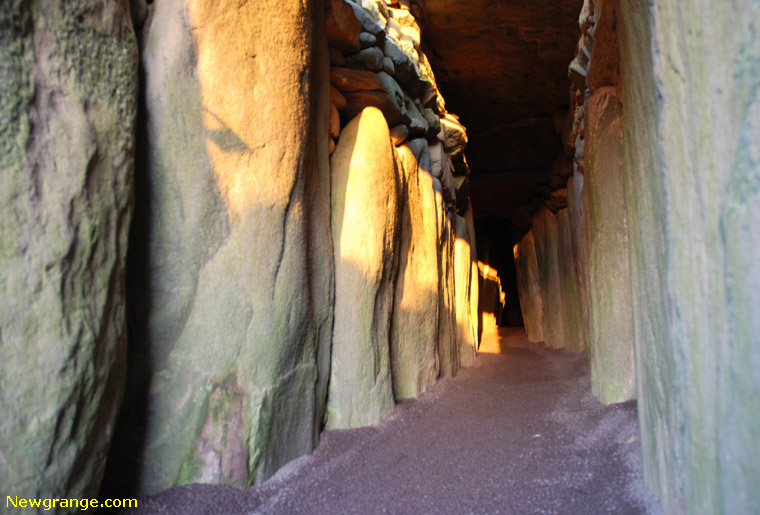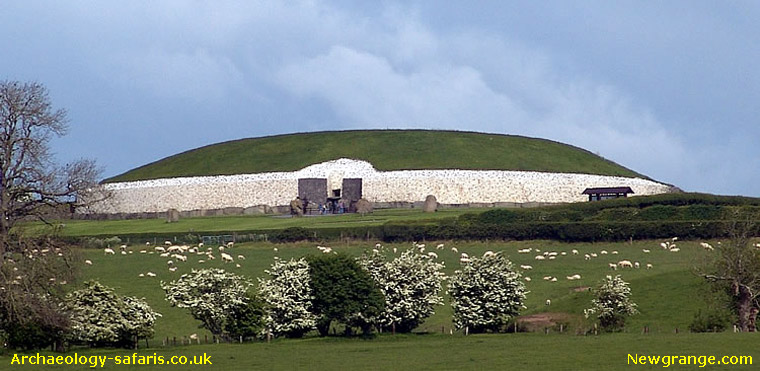The mysteries of Ireland's burial mounds
About a 30-minute drive from Dublin, there is a fertile valley nestled in a meandering loop of the Boyne River in Ireland's Ancient East.
In the Stone Age, an advanced civilization made this tranquil spot home. Settlers raised livestock and tended their crops. As accomplished artists and engineers, they also built sacred enclosures.
Today, many ancient mounds are scattered across the island of Ireland. The most intriguing are called passage tombs, owing to a long corridor leading to a central cross-shaped chamber. Archaeologists long believed the dead were left in these chambers to begin their journey to the Other World.
That association with burial rites overshadowed another aspect of these enigmatic cairns. Rife with symbols and astrological properties, today they are recognized as temples with great ritual significance.
Construction, done without benefit of the wheel or metal tools, took more than 20 years, according to experts. Workers dragged 200,000 tons of loose stones to the mound, digging them from the earth by hand and hauling them 30 miles to the hilltop.
Artisans carved elaborate swirls, zigzags, diamonds, spirals and other geometric designs into the stones. Workers are said to have cut their hands, smashed fingers and feet, fell to disease and drowned in the river while creating these monuments.
The most important is Newgrange. Carbon dating shows it to be one of the oldest man-made constructions on Earth, older than Egypt's ancient pyramids by some 700 years and Stonehenge by 1,000.
Built around 3200 B.C., the heart-shaped hill occupies more than an acre and is surrounded by 97 massive curbstones, some richly decorated with geometric carvings. The tomb is 36 feet high and has a diameter of 280 feet.
The heart is the inner chamber where three recesses — small rooms — form a cross. The intricate corbeled ceiling reaches a height of 20 feet, although the narrow entry passage is much lower. Overlapping stones form a conical dome, topped by a single capstone. This ceiling has been intact more than 5,000 years and still keeps the inner chambers dry.
One of the most impressive features of Newgrange can be seen during the winter solstice. At this time, the sun’s rays penetrate a unique roof box, crawl slowly up the tight 62-foot-long pathway and light up the central burial chamber.
Much about passage tombs remains a mystery. No written language existed at the time of their construction. Sophisticated measuring devices had not yet been imagined.
How could they have designed so precise a structure? Whose remains were left inside? What form of ceremony accompanied interment? What was the significance of the winter solstice?
The last question in particular draws a lot of interest. There is a high demand from visitors who want to see what the interior looks like at this time. A lottery is held to determine who will be admitted: In 2019, nearly 30,500 applications were submitted.
In September, 60 names are drawn, the winners gaining access to this mystical and memorable place.
is a freelance writer living in northern Italy.Private Tour to Newgrange, Knowth, and the Boyne Valley
Embark on a journey through time and heritage with our exclusive private tour to Newgrange, Knowth, and other captivating sites nestled in the enchanting Boyne Valley. Immerse yourself in the rich history and mystique of these World Heritage sites, where ancient wonders come to life.Newgrange and Knowth, both designated as UNESCO World Heritage sites, stand as testament to the ingenuity of our ancestors. Dating back over 5,000 years, these Neolithic passage tombs are older than Stonehenge and the Great Pyramids of Giza. Step inside the chambers of Newgrange, where the winter solstice illuminates a narrow passage, casting an ethereal light on the ancient carvings within. Explore Knowth, adorned with megalithic art, and unravel the mysteries of a bygone era.
Visit the megalithic passage tombs at Newgrange and Knowth with the on-site guide. These are UNESCO World Heritage sites so you will be joining others on the official tour. Beyond the renowned Newgrange and Knowth, our private tour takes you on an intimate exploration of lesser-known gems in the Boyne Valley.
Leave the logistics to us as you embark on a stress-free exploration of the Boyne Valley. Our private tours ensure a personalized and comfortable experience from the moment we pick you up at your accommodation to the time we drop you back.
Boyne Valley Private Day Tour
 Immerse yourself in the rich heritage and culture of the Boyne Valley with our full-day private tours.
Visit Newgrange World Heritage site, explore the Hill of Slane, where Saint Patrick famously lit the Paschal fire.
Discover the Hill of Tara, the ancient seat of power for the High Kings of Ireland.
Book Now
Immerse yourself in the rich heritage and culture of the Boyne Valley with our full-day private tours.
Visit Newgrange World Heritage site, explore the Hill of Slane, where Saint Patrick famously lit the Paschal fire.
Discover the Hill of Tara, the ancient seat of power for the High Kings of Ireland.
Book Now



